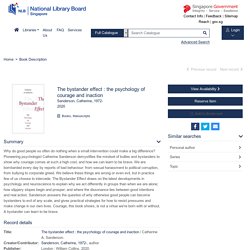

The number of others is paramount given that more bystanders lead to lesser assistance, despite the influence of every additional bystander having a plummeting impact on lending a helping hand. A Summary of the Bystander Effect: Historical Development and Relevance in the Digital Age. Bystander Effect Psychology.
(127) The Bystander Effect: Why Some People Act and Others Don't. From Empathy to Apathy: The Bystander Effect Revisited. The bystander effect and social control behavior: the effect of the presence of others on people’s reactions to norm violations. From boys to Good Samaritans, Opinion News. TODAYonline. A spotlight has been shone on sexual harassment cases in Singapore, with the recent #MeToo movement gaining traction in mainstream and social media.

Currently, efforts towards tackling sexual harassment here are centred on the workplace. In 2015, Singapore launched the Tripartite Advisory on Managing Workplace Harassment, which aimed to be a practical guide for employers and employees to improve the prevention and management of workplace harassment. The Association of Women for Action and Research (AWARE) also publishes reports on sexual harassment at the workplace or among young people in general. What is sorely lacking, however, is information on sexual harassment in our institutes of higher learning. Singaporean universities do not yet have comprehensive anti-harassment policies in place, although most of them have honour codes that remind students to be respectful of one another. Of course, these assurances have to be seen through. But change is necessary, and it needs to start now. Toddler incident in China shows 'volunteer's dilemma'.
A security camera video of a toddler being run over twice on a street in China has swept across the Web in recent days and has drawn a chorus of horrified denunciations.

How, we wonder, could so many passers-by have so callously ignored the girl's plight? As humans, we are horrified when we learn that a person in distress is not helped, even when, as in this case, many potential helpers are present. Our horror increases if the person is victimized in a particularly vicious or careless way by fellow human beings.
New York Today: The City’s Bystander Effect. Good morning on this clear Monday.

The first time I dialed 911 in New York was on a subway platform at 42nd Street — last week. A woman was bleeding on her head and neck; she had fallen on the stairs between the platform and turnstiles. Some passengers hurried past her. Others stopped to look and moved on. Several took out their phones — not to call for help, but instead to record the scene. Maybe you’ve witnessed a similar episode in the city:curious onlookers who hesitate to act, or opt not to do anything at all. It’s often what psychologists call “the bystander effect.” “It’s a general term for people not reacting, when they’re in a group, to some sort of situation that might call for a reaction — where responsible intervention would be the right call, but no one is intervening,” said Katherine Fox-Glassman, a lecturer in the department of psychology at Columbia University, whose research has focused on judgment, decision-making and risk perception.
Here’s what else is happening: Active bystander. Overcoming the Bystander Effect. How to reverse the Bystander Effect. You see a shopper trip over in a busy street.

Someone else can help. That’s what you tell your conscience. This is the Bystander Effect in action – the dilution of our sense of responsibility in the presence of other people – and it’s been demonstrated in numerous studies over many years. But life is complicated and psychologists have begun looking at the circumstances that can nullify or even reverse the effect. For a new paper, Marco van Bommel and his team tested the idea that the presence of others could in fact increase our proclivity for helping if we’re nudged into a self-aware mindset and thereby reminded of our social reputation. Two experiments were conducted using an online chat room for people with extreme emotional problems. In the baseline condition, each participant could see his or her name in the top left-hand side of the screen alongside other users’ names. Marco van Bommel, Jan-Willem van Prooijen, Henk Elffers, and Paul A.M.
Like this: Like Loading... Related. 69b04 vanbommeletaljespinpress. Quiz: Are You A Bully, Victim, Passive Bystander, Or An Active Bystander? The bystander effect : the psychology of courage and inaction / Catherine A. Sanderson. Why do good people so often do nothing when a small intervention could make a big difference?

Pioneering psychologist Catherine Sanderson demystifies the mindset of bullies and bystanders to show why courage comes at such a high cost, and how we can learn to be brave. We are bombarded every day by reports of bad behaviour: from sexual harassment to political corruption, from bullying to corporate greed. We believe these things are wrong or even evil, but in practice few of us choose to intercede. The crime of complicity : the bystander in the Holocaust / Amos N. Guiora. "If you are a bystander and witness a crime, should intervention to prevent that crime be a legal obligation?

Or is moral responsibility enough? In The Crime of Complicity, Amos N. Guiora addresses these profoundly important questions and the bystander-victim relationship from a deeply personal and legal perspective, focusing on the Holocaust and then exploring cases in contemporary society. Sharing the experiences of his parents, who were Holocaust survivors, and his grandparents, who did not survive, and drawing on a wide range of historical material and interviews, Guiora examines the bystander during three distinct events: death marches, the German occupation of Holland, and the German occupation of Hungary. He explains that while the Third Reich created policy, its implementation was dependent on bystander non-intervention.
Emily is being bullied, what can she do? : a story and anti-bullying guide for children and adults to read together / Helen Cowie, Harriet Tenenbaum and Ffion Jones ; illustrated by Ffion Jones.